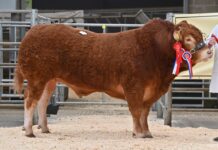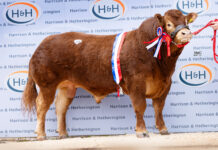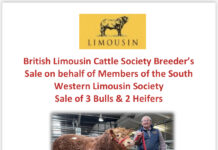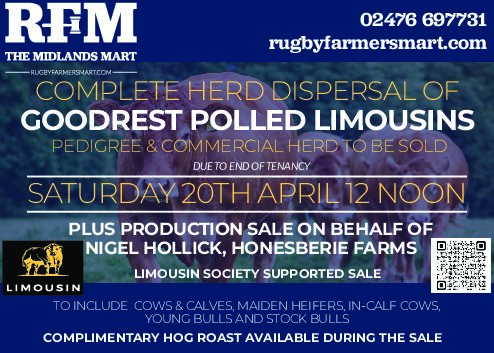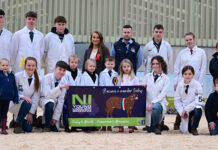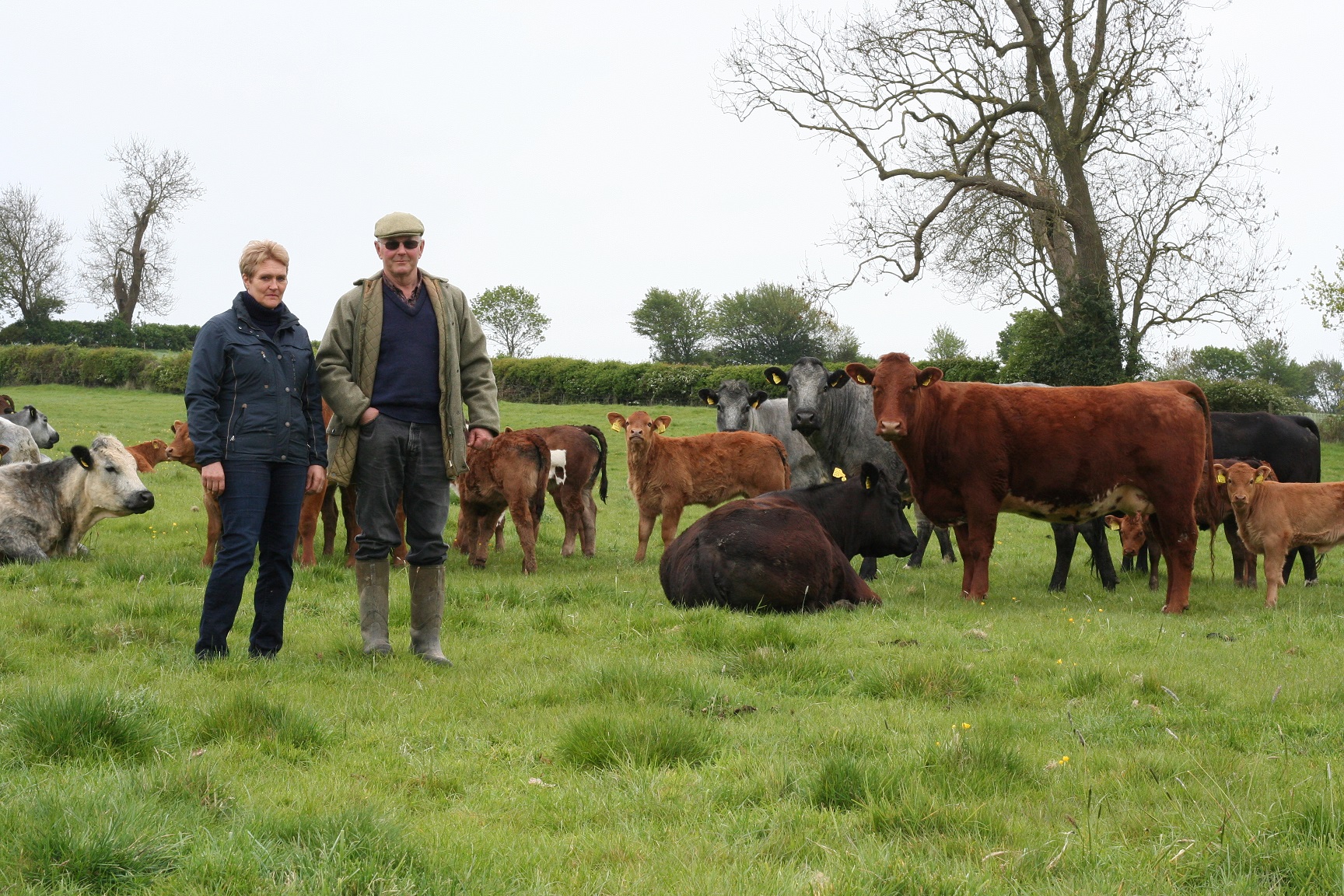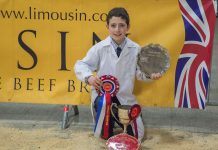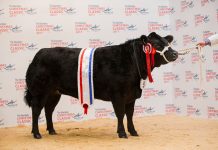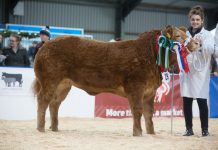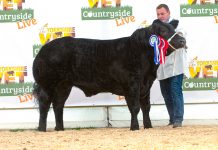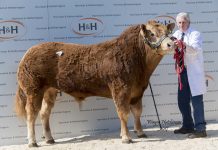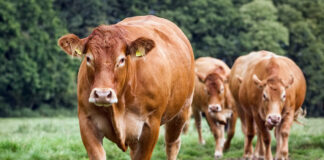Guest writer James Hazard reports on the central role of Limousin genetics in the 150 cow suckler herd of Robert and Sue Scott, Ayston, Rutland.
In the heart of the country’s smallest county of Rutland, and set in the most beautiful rolling countryside, lies a very well organised and driven farming family owned by Robert and Sue Scott, trading as Scott & Scott (Ayston) Ltd. The farm is situated in the idyllic village of Ayston, one mile away from the market town of Uppingham.
The farm has been in the family since 1913, originally run by Roberts’s grandfather who was a true stockman and grazier. It was then progressed and expanded by Roberts’s father into a mixed farm and now with Robert and wife Sue at the helm it totals some 1100 acres with 150 mainly Limousin sired suckler cows. Both Robert and Sue are very busy with all farming activities as you can imagine but Sue also runs a bed and breakfast and a small livery yard for horses. Day to day activities are undertaken by Robert and Sue who partake in every aspect of the business. Their son-in-law Ed Bell runs the majority of the arable operation but also aids feeding during the winter months when the cattle are housed. This year the family have taken an apprentice under their wing and there is no doubt that Harry will be very well looked after and will learn very valuable lessons working for this progressive farming operation.
The farm is split over two sites totalling 1100 acres. Of this 400 acres is down as grass with the remainder drilled with cereals. Wheat is grown aiming to produce high end bread and biscuit quality grain, spring barley, beans, oil seed rape and spring oats. The grassland is not of the highest quality and is dotted all around the farm where arable production is not suitable. Therefore groups of cows and calves are stocked quite thin to clear up the large areas of rough pasture.
The suckler herd started some 35 years ago for two main reasons, firstly to clear up the rough pasture but also to get away from health issues they found rearing calves. Limousins were soon selected as the breed to use as, “they seemed to be the quality commercial cattle that the market wanted, Limousins just ticked all the boxes.” Viewing a number of fatstock shows in the local area, the late Mr Geoff Watchorn of the Loodal herd was in winning ways more often than not with his Limousin cattle. “Geoff was very helpful to us and we subsequently bought our first two Limousin bulls from the Loodal herd,” commented Sue.
The impressive suckler herd now totals 150 spring calving suckler cows, which are mated with six Limousin bulls and one British Blue bull. The herd has been closed for 20 years, only buying in bulls from herds that have a high health status. Around nine years ago the veterinary practise approached Robert and Sue to carry out an XL veterinary group project as they had funding to carry out testing for the four main health diseases, namely Johnes, BVD, IBR, Lepto. “We were fortunate that we were clean of Lepto and IBR at the very beginning. This was a good base for us to quickly take aim at being clear of everything and we saw the benefits in doing so.” The herd today is monitored and proud to be BVD clear and Johnes monitored clear, with all stock bulls tested annually for Johnes disease before turnout.
“Health is paramount to us, health, fertility and productivity is what we strive for.”
Therefore Robert and Sue like to select from high health herds and buy bulls privately, selecting on ease of calving, conformation and temperament. Two bulls from the recently dispersed Millington herd have left their stamp on the herd, firstly Millington General, sired by Objat and out of the French dam Noce, who is a full sister to the noted Mas Du Clo. With quality bloodlines and good figures sporting an impressive Beef Value of LM48, he is leaving very smart offspring finishing very well. The other sire is Millington Donut, who is sired by Mas Du Clo and out of the Broadmeadows Cannon sired brood cow Ronick Nestle. Again this bull has been a great acquisition to the herd and has really left his stamp.
A real powerhouse of a bull in the field, Lowgate Grant from the high health herd of Ian and Jenna Brown in Lincolnshire, is leaving powerful females with length and top. Grant is sired by the Fieldson Alfy son Threaphurst Dynamo and is out of Lowgate Rosie, a Goldies Oswald daughter.
There is also Fieldson Icandy, sired by the Objat son Sarkley Cossack and out of the Goldies Uppercrust dam Fieldson Candy, from the noted herd of the Fieldson family who are also from Lincolnshire. This bull has proven to be short gestation and easy calving, and is leaving calves with shape and style.
Two further Limousin bulls came from the Cambridgeshire based Greensons herd of Guy Green. Both Greensons Jarrah and Greensons Larkin are sired by the short gestation, easy calving sire Greensons Howlett. Firstly is Greensons Jarrah, who is sporting a fantastic set of EBV’s for not only calving but for growth rates and maternal qualities also. He is out of the Wilodge Cerberus sired dam Whinfellpark Fable and is proving a big hit for the herd, “He has been very easy calving and left some good calves in his first year and therefore we have put him in with the heifers,” commented Robert. The second bull, Greensons Larkin, is out of the Greensons Ural sired dam Greensons Amour. He too has tremendous EBV’s with an overall Beef Value of LM51 and Robert and Sue watch keenly the development of his progeny in his first year. Semen from the sire of both bulls Greensons Howlett can be purchased on the Semenstore website.
Most recently the Scotts have acquired the young bull Tomschoice Milord, sired by the popular easy calving sire Kaprico Eravelle, from the Yorkshire base herd of James Cooper. Milord is out of Tomschoice Governess who is sired by Homebyres Drummie. Again a young bull with very good gestation and calving figures Tomschoice Milord also has very good growth rates. A jump of semen was taken by James Cooper prior to departure and is another marketed via the Semenstore website.
The farm had produced for a number of years produced store cattle, selling stores at Newark Livestock market at the April ‘Limousin Day’ sale, where the cattle met a flying trade on many occasions and selling to many repeat customers. However, a slight change has seen a move recently to finishing all the offspring as the farm produces the grain that allows this. “It also gives us a wealth of information on the bulls progeny but also which cow families are producing the growth rates and quality we are trying to achieve,” added Robert.
The cows are wintered inside on a limited grass silage ration along with ad lib straw prior to calving. As soon as cows start calving down, they are given ad lib grass silage before being turned out from the end of March onwards as calves are born, weather permitting. First calved heifers are given a little bit of home mix ration to aid them a little after calving. During the summer months calves are offered creep feed to aid growth rates and when the grassland starts to burn up into August. The creep is introduced starting with home grown whole oats in August and then moved onto the home grown mix ration. This ration is made up of a mixture of the home produced cereals, barley, beans, and oats along with a little 38% liquid protein molasses to act as a dust buster but also to bump up the protein level in the ration.
“Where we can, we make full use of the cereals we grow on the farm.”
Calves are then weaned around the end of October, the cows are kept inside to dry off after weaning before being pregnancy scanned, before being turned out to grass again therafter. Depending on the season cows are then left out running thinly over the acres for as long as possible with the aim to keep them out until the first week of December.
Now that Robert and Sue have taken the decision to finish all the offspring, I was shown around the yards of finishing cattle and saw a tremendous run of cattle with pen after pen of quality throughout. Finishing cattle are fed in bunkers with around 6-7kg / head / day of home grown cereals, 1kg of the 38% protein molasses and around 7-8kg of grass silage. “Keeping the ration simple with quality home produced feed makes it simple and cost effective,” said Robert.
In conclusion Sue said that the aim of the business is, “to produce the ultimate butchers’ animal in a cost effective manner.” Limousin genetics are the important and central part of meeting that objective.
Many thanks to both Robert and Sue for showing me around their herd which is an absolute credit to their selection and efforts over the years. I have no doubt they are producing exactly what the market is requiring with a very watchful eye on cost.


